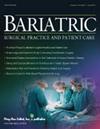Goal-Directed Fluid Management Using Plethysmographic Variability Index in Patients Undergoing Laparoscopic Bariatric Surgery
IF 0.3
4区 医学
Q4 NURSING
引用次数: 0
Abstract
Background: Optimal intraoperative fluid management is essential in surgical patients, including individuals with obesity undergoing bariatric surgery. The objective of this study was to assess the feasibility of pleth variability index (PVI) for intraoperative goal-directed fluid management in comparison with standard approach, in patients with obesity undergoing laparoscopic bariatric surgery. Methods: A total of 60 patients with obesity who underwent elective laparoscopic bariatric surgery were included in this single-blind prospective randomized study. Patients were randomly assigned to the PVI group or control. Patients were monitored for PVI, heart rate, noninvasive mean blood pressure, and perfusion index. In addition, administered fluids, amount of bleeding, and renal function parameters were recorded. Results: The PVI group received higher amounts of crystalloids (3053 ± 275 mL vs. 1703 ± 349 mL, p < 0.001) and colloids (277 ± 208 mL vs. 17 ± 91 mL, p < 0.001) intraoperatively, and it had higher perioperative urine output. In addition, the PVI group had decreases in blood urinary nitrogen (BUN), lactate, and creatinine levels; however, controls had increased BUN, lactate, and creatinine. Conclusions: Findings of this study suggest that PVI may represent a useful noninvasive strategy for intraoperative goal-directed fluid management in patients with obesity undergoing laparoscopic bariatric surgery.腹腔镜减肥手术患者使用Plethymographic变异指数的目标导向液体管理
背景:最佳的术中液体管理对外科患者至关重要,包括接受减肥手术的肥胖患者。本研究的目的是评估在接受腹腔镜减肥手术的肥胖患者中,与标准方法相比,体积变异指数(PVI)用于术中目标导向液体管理的可行性。方法:将60例接受选择性腹腔镜减肥手术的肥胖患者纳入这项单盲前瞻性随机研究。患者被随机分配到PVI组或对照组。监测患者的PVI、心率、无创平均血压和灌注指数。此外,记录给药液体、出血量和肾功能参数。结果:PVI组在术中接受了更高量的晶体(3053±275 mL vs.1703±349 mL,p<0.001)和胶体(277±208 mL vs.17±91 mL,p>0.001),并且围手术期尿量更高。此外,PVI组血尿素氮(BUN)、乳酸和肌酸酐水平下降;然而,对照组BUN、乳酸和肌酸酐增加。结论:本研究结果表明,PVI可能是腹腔镜减肥手术中肥胖患者术中目标导向液体管理的一种有用的非侵入性策略。
本文章由计算机程序翻译,如有差异,请以英文原文为准。
求助全文
约1分钟内获得全文
求助全文
来源期刊
CiteScore
0.80
自引率
0.00%
发文量
36
期刊介绍:
Bariatric Surgical Practice and Patient Care is the essential peer-reviewed journal delivering clinical best practices and quality updates for achieving optimal bariatric surgical outcomes.
Bariatric Surgical Practice and Patient Care coverage includes:
Quality outcomes measurement and reporting
Process innovations and care delivery
Short- and long-term surgical complications
Pre-surgical diagnosis and consultation
Pre-op, peri-op, and post-op standards of practice
Patient access
Patient safety issues
Nutritional and dietary support
Bariatric surgical emergencies
Best practices and current standards for bariatric surgery
Culture and ethics
Body contouring and reconstructive surgery
Bariatric teamwork and communication.

 求助内容:
求助内容: 应助结果提醒方式:
应助结果提醒方式:


